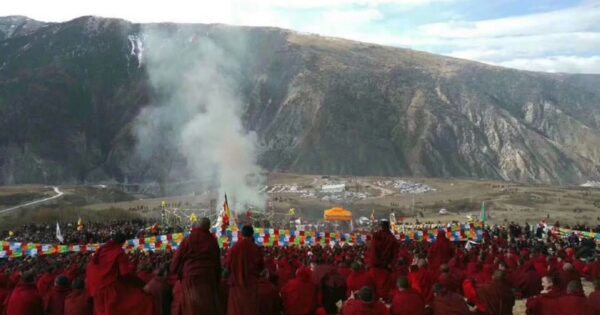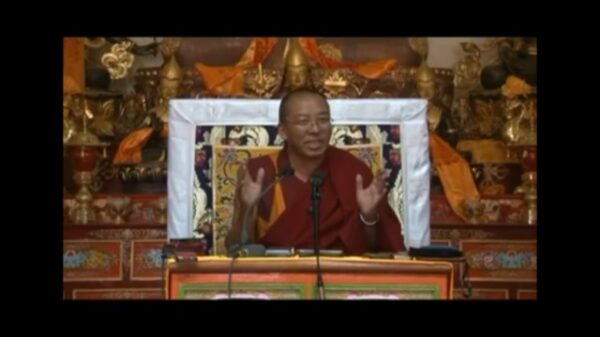Thousands of religious masters, monks and laypeople gathered in Tibet earlier this month to mourn the death of Geshe Jampel Loshe, a Buddhist teacher who played a critical role in revitalizing Buddhism in Tibet after returning to his homeland from India.
Geshe Jampel Loshe, who was in his early 50s, passed away on Oct. 19 following a period of illness and was cremated on Nov. 4 in the area of Kham, eastern Tibet, where he was born. Footage and images circulating on social media showed mass gatherings of Tibetans at prayer services at his cremation.
Based at Sershul (Chinese: Shiqu) monastery in Kardze (Chinese: Ganzi) Tibetan Autonomous Prefecture, Sichuan, the area of Tibet where he was born, Geshe Jampel Loshe led a revitalization of Buddhist religious practice and scholarship.
Importantly, he was among few Tibetan monks educated in India who had been able to return to continue their study and practice in Tibet. This has become increasingly difficult as Chinese authorities—who have illegally ruled over Tibet, a historically independent country, since 1959—increasingly aim to undermine and supplant the Tibetan religious hierarchy and weaken the authority of legitimate Tibetan religious leaders both inside and outside Tibet, including monks educated in exile.
In Lithang (Chinese: Litang), another area of Kham, a recent ruling stated that only monks who had received the People’s Republic of China-administered version of the Tibetan Buddhist degree of Geshe would be allowed to teach Buddhism in the area. Tibetan sources have confirmed that Chinese authorities have been imposing the same restrictions elsewhere, including at Labrang Tashikhyil Monastery (Chinese: Labuleng Si) in present-day Kanlho Prefecture (Chinese: Gannan) of Gansu Province.
Monks who have studied in India are highly valued for their knowledge and practice, particularly as they have had the opportunity to study and attend teachings by the Dalai Lama.
Geshe Jamphel Loshe attained his Geshe degree, the highest level of scholarship in Tibetan Buddhism, at the re-established Sera monastery in South India. He returned to Tibet in 2001 following a specific request from Sershul monastery. In Tibet, he taught young monks and was recognized by the Chinese authorities as an important visiting teacher for various universities and institutions.[1]
Founded in 1760, Sershul is a large monastery of great historic and religious significance, famous for its scholarship.[2] It contains relics linked to Nalanda monastery in India, whose teachings were famously preserved by Tibetan masters, and has an Institute for Higher Buddhist Studies.
Tributes pour in
Indicating his significance to the Tibetan people and integral role in the survival of Tibetan Buddhism on the Tibetan plateau, there was an outpouring of tributes to Geshe Jampel Loshe after his death from many intellectuals and religious masters inside Tibet.[3]
His death was “a huge loss for wisdom and a victory for ignorance,” a Tibetan writer said in a post on social media. “His departure is like the disappearance of a bright shooting star who educated and inspired people to fulfill their potential of a meaningful life in this disturbing era when people are wasting their time on gossip and chat via the internet.”
A Geshe from Labrang in the Tibetan area of Amdo said: “It is rare for someone to have reached this position of dedicated practice; there are very few in Tibet who serve Tibetan Buddhism through teaching [oral transmission], debating and writing.”[4] Another teacher wrote: “The passing of [Geshe Jampel Loshe] is a devastating blow to the restoration of Buddhism and revitalization of traditional Buddhist philosophical debate in Tibetan areas.”
Another teacher, also a Geshe, posted a tribute saying that Geshe Jampel Loshe was “hugely influential” in the study of Buddhism in Tibetan monasteries. He said that Geshe Jampel Loshe not only had a high level of education and teaching skills but always personally addressed management issues at his monastery, ensuring the system was continually improved and motivating individuals to work on their studies and follow monastic practice.
A teacher in Ngaba (Chinese: Aba), Sichuan, the Tibetan area of Amdo, said: “[Geshe Jampel Loshe] was a true teacher and scholar, and the grief and regret are immeasurable. Even [as monks, who are taught to accept death] we want to rebuke the nature of death after your unexpected departure. A person like you is too precious and rare in Tibet with all the aspects of in-depth knowledge, courage, a skillful leader of debate, transcendent brilliance of your writing, infused with wisdom, as well as great Tibetan patriotism and loyalty.”
A scholar at the North-West Minorities University in Lanzhou recalled Geshe Jampel Loshe’s visit there to teach, saying: “An ironsmith hammers iron, a goldsmith hammers gold, was one of his views on theocracy while he was lecturing in North-West Minorities University last year. With this view, we could gauge his open-mindedness and long-term perspective. We had a very relaxed conversation with much laughter about culture […] that gave me the opportunity to note his beautiful, optimistic, lively and cheerful personality…The unexpected departure of such a precious, knowledgeable and motivated person is a huge loss for both the ironsmith and the goldsmith. May this note be a small tribute to his funeral ceremony.”[5]
Another Tibetan religious scholar wrote: “A great pillar of Buddhism has collapsed, the brightest light has been extinguished, it was clear that you sacrificed all for Buddhism and the [Tibetan] ethnicity. Great masters and teachers should be more concerned and care more about their health, because we [Tibetans] really need you, please, may you accept to live longer.”[6]
Cremation attended by many
Religious representatives and reincarnations from across various religious traditions together with hundreds of monks attended the cremation for Geshe Jampel Loshe on Nov. 4 near his monastery, Sershul.
A relative living in Switzerland told Radio Free Asia’s Tibetan Service that Geshe Jampel Loshe had been treated at an army and a civilian hospital for an illness related to his white blood cells. His body was returned to Sershul monastery, and prayer ceremonies were held for him in various Tibetan areas both in Kham and in Amdo, where monks held gatherings in Rebkong (Chinese: Tongren) and Golog (Chinese: Guoluo) in Qinghai.
The tributes to Geshe Jampel Loshe and accounts of his life’s work demonstrate the diverse and determined ways in which Tibetans seek to protect and develop Tibetan Buddhist study and practice in Tibet, despite intensified efforts by the Chinese authorities to “Sinicize” Buddhism—meaning to bring it under the control of the Chinese government.

Image circulated on social media of the cremation on Nov. 4 of Geshe Jampel Loshe near Sershul monastery in Kham, the eastern region of Tibet.

A memorial to Geshe Jampel Loshe created by Chinese followers at Shenyang in Liaoning Province, China. Image from Chinese language media (Phoenix) at: https://fo.ifeng.com/c/7qynTlgtlS0

Caption: Geshe Jampel Loshe teaching (still from a video circulating on YouTube).
Footnotes:
[1] This article about Geshe Jampel Loshe appeared in the state media in Tibetan in 2016: https://ti.tibet3.com/culture/gyunshes/2016-11-19/15543.html
[2] For a video of the monastery with English subtitles, see the Kham Film Project at: http://www.khamfilmproject.org/sershul-tib/
[3] A video compilation of his teachings and prayer ceremonies after his death was posted online at: https://www.youtube.com/watch?v=UzoSmVmVp_c
[4] The International Campaign for Tibet monitored these posts online, and translated them from the Tibetan. Full identities are not given here as permission was not sought for publication internationally in English in this report.
[5] The writer was indicating that his few words were a drop in the ocean of the Geshe’s service, which is too vast to summarize.
[6] This comment reflects the Tibetan Buddhist belief that if a religious master has reached a high enough level of meditative stabilization he or she can determine the conditions of a rebirth and influence the way in which they die. The writer may also believe that Geshe Loshe spent so much time and energy teaching and caring for other monks that he did not pay due attention to his illness.

